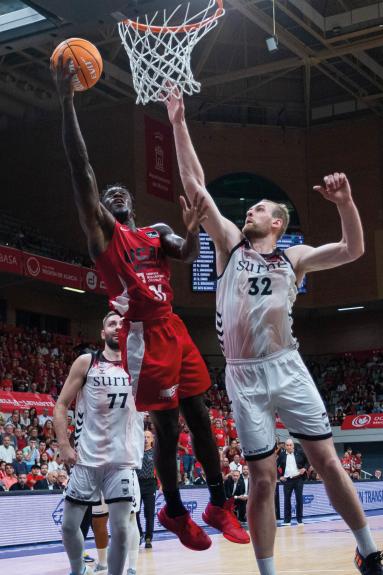
Master´s Degree inHigh Performance Sport: Strength and Conditioning
Credits
- Compulsory (CO): 42
- External Practices (EP): 6
- Master final Project (TFM): 12
- Total Credits: 60
Curriculum
Subject | ETCS | Academic Term |
| I. Research Methodology | 10.0 | 1º |
II. Computer and Research Methods in Strength and Conditioning | 3.5 | 1º |
| III. Scientific Principles of Strength and Conditioning | 4.5 | 1º |
| 4.5 | 1º | |
| 4.5 | 1º | |
| 6.0 | 2º | |
| 4.5 | 2º | |
| 4.5 | 2º | |
| IX. Practicum | 6.0 | 2º |
| X. Master's Thesis | 12.0 | 2º |
| Total | 60.0 |
To access the Teaching Guides (Guía Docente) for each module, click on the name of the module above.
The official presentation of the master's program will be held during the first day of class on Wednesday, January 23, 2019 at 9:00am with Research Methodology (Module I) in Pavilion 5, classroom 14A.
Schedules and Exams
- Wednesday, Thursday and Friday, from 09:00h until 14:00h.
Module I. Research Methodology
The rationale for this module is to facilitate all students, some of who may not have the necessary research training, into the world of research methodology. It’ll provide the foundation necessary for students to conduct scientific work.
Module II. Research and Computer Methods in Strength and Conditioning
This module will prepare students on how to apply statistics on variables used in sport science. Students will become familiar on how to treat, analyze and interpret data collected from study experiments. Specifically, students will be able to: compare descriptive statistics, construct and analyze statistical graphs using computer software, calculate probabilities using laws of probability and discrete and continuous probability distributions, estimate parameters with confidence intervals, perform hypothesis tests, create and apply regression models based on experimental data and evaluate published statistical results.
Module III. Scientific Principles of Strength and Conditioning
This module will cover: neural mechanisms involved in strength and power, recruitment of selective motor units, electromyography, increased firing frequency, total increase recruitment, mechanics involved in muscle strength and power, muscle hypertrophy, muscle fiber type, muscle protein expression, musculoskeletal stiffness, muscle architecture.
Module IV. Exercise Physiology
This module seeks to examine the acute and chronic responses to anaerobic and aerobic training, specifically the endocrinological, biochemical, immunological, molecular and biological adaptations. Additionally, detraining and concurrent strength and endurance training will be studied.
Module V. Biomechanics and Movement Analysis
This module introduces students to the concepts that affect human movement, including the laws of physics, which govern the interaction of the human body with its environment, with particular reference to strength and conditioning exercises. The mechanics of the human body as a machine will be examined in detail.
Module VI. Program Design as related to Strength and Conditioning
This module examines the advanced study of resistance training with specific emphasis on hypertrophy, strength and power. Topics that will be covered include: plyometrics, Olympic lifts and their variants, sport-specific resistance training and power optimization, and the theory and integration of the annual plan in relation to preparation of elite athletes and teams.
Module VII. Sports Nutrition and Ergogenic Aids
This module will review: the classification and function of essential nutrients during exercise, essential elements of an athlete’s diet, ergogenic aids, specific nutritional supply in different sports (e.g., endurance strength, team, combat), and food in special situations.
Module VIII. Strength Training and Conditioning in the Elderly
Module contents include: a) conditional evaluation of the elderly, b) changes in the anatomy and physiology of the organs and systems during the aging process, c) assessments of risk factors for coronary heart disease, other diseases and lifestyle, d) psychological aspects of aging, e) physical activity and its relationship to the diseases of aging, f) gait biomechanics, g) new methods of science-based training, and h) considerations for designing programs for older adults.
The practicum builds upon and consolidates skills and knowledge acquired from the curriculum. Students further their understanding of theoretical concepts of strength and conditioning by developing and conducting their Master’s thesis project, under the guidance of an advisor in the related field of interest. Much of the weight of the practicum lies in conducting research practices.
Practical experiments are generally performed in the Biomechanics Laboratory, Research Center in High Performance Sport, and UCAM Sports Center. Students can also apply to carry out their practicum at Porto University (Portugal). A minimum 3 months stay is required if students are approved to conduct their practicum at Porto University.
To obtain the Master’s Degree in High Performance Sport: Strength and Conditioning, all students must successfully pass the Master’s Thesis (MT). The MT should reflect the knowledge and skills acquired from the curriculum. The MT will be original, unpublished and will address issues related to the practices carried out during the Practicum. Students will publicly present and defend their Master’s thesis. Overall, the MT content and size must be proportional to 12 ECTS (300 hours).
More information
What does this program include?
- Official printed study manual, depending on the chosen certification:
- Fundamentals of Personal Training (NSCA-CPT®)
- Principles of Strength and Conditioning (CSCS®)
- Official exam fee included, according to the student’s academic profile (NSCA-CPT® or CSCS®)
- CPR and AED use course, a mandatory requirement for certification
- Academic orientation session and personalized follow-up, conducted by the NSCA Spain teaching team



